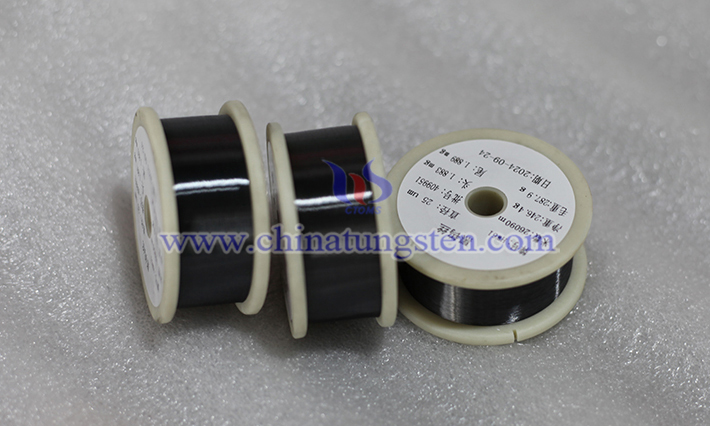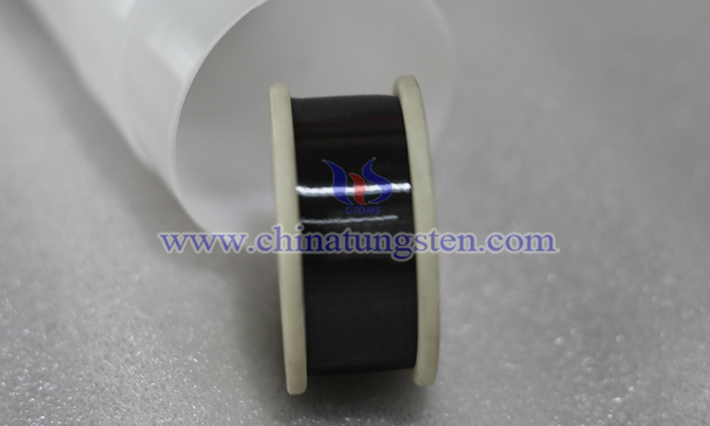Physical Properties of Black Tungsten Wire
- Details
- Category: Tungsten Information
- Published on Wednesday, 13 August 2025 18:46
- Written by Zhenghua
- Hits: 5
Due to its unique physical properties, black tungsten wire is widely used in lighting, electronics, and high-temperature industrial applications. Tungsten has the highest melting point of any metal in the periodic table, and its physical properties give black tungsten wire its exceptional performance. The following details its key physical properties.

1. High Melting Point
Tungsten has an extremely high melting point of approximately 3422°C (6192°F), the highest of all pure metals. This allows black tungsten wire to maintain structural stability in extremely high-temperature environments, making it widely used in heating elements for incandescent light bulbs, vacuum tubes, and high-temperature furnaces. Even at temperatures approaching 3000°C, tungsten wire maintains its mechanical strength, preventing melting or deformation.
2. High Density
Tungsten has a density of 19.25 g/cm³, similar to that of gold and uranium. This high density gives black tungsten wire a high mass concentration, making it suitable for applications requiring high strength and compact design, such as targets for X-ray tubes. However, this high density also makes it more difficult to process, requiring precision equipment for drawing and forming.
3. Excellent Hardness and Strength
Tungsten possesses extremely high hardness (approximately 7.5 on the Mohs scale) and tensile strength. Black tungsten wire undergoes multiple drawing and heat treatments to optimize its crystal structure, further enhancing its tensile strength and wear resistance. This makes it excellent for high-stress environments, such as arc lamps or welding electrodes.

4. Low Coefficient of Thermal Expansion
Tungsten has an extremely low coefficient of thermal expansion of approximately 4.5 × 10⁻⁶/°C. This means that black tungsten wire exhibits minimal dimensional change at high temperatures and maintains shape stability, making it suitable for use in precision instruments and high-temperature equipment, such as thermocouples and filament holders, to avoid structural failure caused by thermal expansion. 5. High Electrical and Thermal Conductivity
Although tungsten's electrical conductivity is lower than that of copper or silver, it still exhibits excellent electrical conductivity at high temperatures, with a resistivity of approximately 5.5×10⁻⁸ Ω·m (20°C). Furthermore, its thermal conductivity is approximately 173 W/(m·K), effectively dissipating heat and making it suitable for high-power electronic devices.
6. Corrosion Resistance
Tungsten exhibits good corrosion resistance to most chemicals (such as acids and alkalis) at room temperature, but it readily forms oxides (WO₃) in high-temperature oxidizing environments. Therefore, black tungsten wires are often used under vacuum or inert gas protection to extend their life.
7. Other Characteristics
The surface of black tungsten wires is typically black or grayish-black (due to the application of graphite emulsion during processing). Its elastic modulus is high (approximately 400 GPa) and its deformation capacity is limited, but annealing can improve its ductility. Furthermore, tungsten's low emissivity (approximately 0.1-0.3) makes it highly efficient in radiative heat transfer.
- Chinatungsten Online: www.tungsten.com.cn
- CTIA GROUP LTD: en.ctia.group
- Tungsten News & Price: www.ctia.com.cn
- Molybdenum News & Price: news.molybdenum.com.cn
- Tel.: 86 592 5129696; Email: sales@chinatungsten.com





 sales@chinatungsten.com
sales@chinatungsten.com